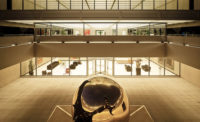As a partner to the Paralympics since 1988, and with customers in 100 countries, Ottobock, a designer and manufacturer of prosthetic and orthotic devices and other mobility products, is a global citizen. Founded by German prosthetist Otto Bock in 1919, the company now employs 5,000 people in 46 locations around the world. It established its first North American office in Minneapolis to serve World War II and Korean War veterans in 1958. In 2015 Ottobock relocated its North American Headquarters to Austin, Texas, wanting to capitalize on the city’s reputation as a hub for technology and innovation. With the goal of attracting a fresh crop of talented employees, it commissioned the Austin office of Page to design a new headquarters in a raw, 37,000- square-foot space of an existing commercial building north of the city’s downtown.
Ottobock’s core mission is to help people move with greater ease, and it has pioneered manufacturing techniques that allow its products to have a custom fit, due to highly adaptable components. Such a strategy helped define design goals for the office. “It’s sculptural, it’s precise, it’s anthropomorphic,” says Page principal Wendy Dunnam Tita. In addition to creating a space that would communicate high-tech bona fides, the company wanted to connect with Austin’s authentic, edgy vibe, bringing rougher materials into the mix. Page exposed the base building’s concrete joists and columns, then added curving walls and sleek planes of glass and laminate to gently sculpt the interior. According to Dunnam Tita, this type of new intervention was part of the Ottobock aesthetic.
The office does not shy away from openness or changes in elevation—both speak to its culture of accessibility, in the physical sense and in terms of company hierarchies. “The business is open and accessible. Not every conversation has to be behind a closed door,” says Sara Gardner, director of marketing communications for Ottobock North America. To create a more vertical experience, Page embraced the use of ramps and an elevated floor in places. “We wanted everything to be not only ADAcompliant, but also very fluid,” says Dunnam Tita. A pathway through the office connects employees with social zones and directs foot traffic away from workstations. Raising the floor in the southeast and northwest sections of the office ensures that even workers not seated near windows have access to daylight and views. Internal offices have backlit panels that simulate skylights.
The design evolved as a response to drawbacks of open-plan work environments—namely, acoustic disruption. Placing air ducts entirely under the floor kept the ceiling more open, allowing Page to install acoustic panels over workstations. In some meeting areas, employees can draw a thick acoustic drape to define a quiet, private area.
Visitors who come for equipment training sessions first encounter a showroom detailing the company’s history. Here, products are elevated as sculpture. “It’s first, experiential and, second, informational,” says Gardner. “I see a perfect reflection of what we do, which is the meeting of man and machine, of organic and technical.” At a housewarming ceremony for the new offices, regional president and CFO of Ottobock North America Andreas Schultz spoke about the challenges of establishing a new team in Austin—of the approximately 100 employees in the office, only about one-third were relocated from Minneapolis. The office needed to build on Ottobock’s culture of innovation while maximizing efficiency and being able to respond to growth. “From the time we moved in, we have seen increased collaboration and communication, and over the past years we see growth beginning to justify the investment,” he said.
For people who have lost their range of movement, marrying the body to technology can restore a sense of humanity. And by considering how people will continue to interact with their work environments, the new headquarters should allow Ottobock to offer a similar experience to employees.
Back to Good Design Is Good Business 2017
CreditsArchitect: Page
Personnel in architect's firm who should receive special credit: Page:
Architect of record: Page
Engineers Page (structural, m/e/p)
Consultants Planning: Ottobock Internal Team, Vitra, & Page
General contractor: Balfour Beatty Construction
Photographer: Casey Dunn Photography
|
SpecificationsStructural System Project was within an existing concrete shell building. Additional steel included significant custom fabricated steel structures to accommodate cantilevered steel canopy and ceiling structures in addition to moveable glass wall system. All are concealed within sculptural drywall enclosures. Interior framing for drywall partitions is light gauge metal framing. Interior glazed ceilings use structural tube steel. This steel was painted. Manufacturer of any structural components unique to this project: The steel subcontractor was G.W. Slade Consultants Inc. Glazing Other: Storefront glazing - Celestra pleinAir Hardware Other special hardware: FSB, Rockwood, Dorma, Schlage, Glynn Johnson Interior Finishes Acoustical ceilings: Fiberglass - Armstrong Demountable partitions: Demountable/Moveable Partitions: Nanawall HSW75 Paints and stains: Sherwin Williams - Acrolon 100 Solid surfacing: Dupont - Corian Special surfacing: Recycled Acrylic - 3Form, Chroma Floor and wall tile: Daltile - Volcano Stone Resilient flooring: Floor Vinyl: Carpet: Flor - Recycled Nylon Raised flooring: Tate ConCore - CC 1250 Special interior finishes unique to this project: Wallbase - Aluminum, Gordon Fabrics: Flooring: Wall glass: Glass front lockers: Hollman Furnishings Office furniture: Vitra Reception furniture: Vitra Fixed seating: Vitra Chairs: Vitra Tables: Vitra Upholstery: Vitra Other furniture: Hatch Workshop - 30' Reclaimed Pecan Conference/Dining Table Lighting Interior ambient lighting: Finelight Downlights: Focal Point Tasklighting: Vitra Dimming system or other lighting controls: Acuity Brands, Inc. - night Network Control System from Sensor Switch Conveyance Accessibility provisions: Tate ConCore CC1250 Energy Energy management or building automation system: - Chilled Beams (perimeter windows): SLT Schanze Lufttechnick GmbH, AKK Add any additional building components or special equipment that made a significant contribution to this project: Other Lighting: |











Post a comment to this article
Report Abusive Comment